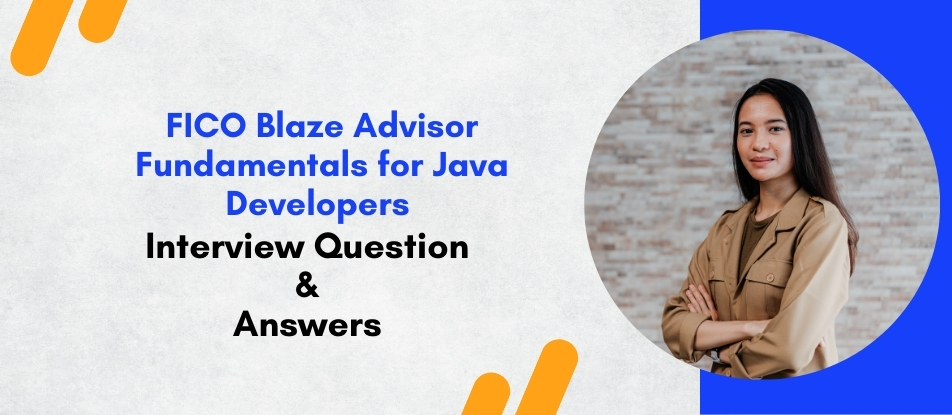
The FICO Blaze Advisor Fundamentals for Java Developers course equips participants with the skills to develop and integrate business rules using FICO Blaze Advisor in Java-based systems. It covers rule authoring, decision flows, version management, and deployment best practices, enabling developers to separate business logic from application code effectively. With a focus on real-world scenarios, the course emphasizes performance optimization, scalability, and collaboration between business and IT teams for delivering agile, rules-driven enterprise solutions.
FICO Blaze Advisor Fundamentals for Java Developers Training Interview Questions Answers - For Intermediate
1. What is the role of the Rule Engine in Blaze Advisor?
The Rule Engine in Blaze Advisor executes business rules defined in the repository or decision service. It interprets conditions, evaluates data against defined logic, and triggers actions based on outcomes. By separating rule execution from application code, it ensures flexibility, scalability, and maintainability while enabling quick adaptation to business changes.
2. How does Blaze Advisor ensure platform independence for rule execution?
Blaze Advisor generates Java components or web services for deployed decision logic, enabling them to run on any platform supporting Java or standard web technologies. This independence allows rules to be integrated into different enterprise environments, including on-premise and cloud-based architectures, without code modifications.
3. What is the significance of Rule Priorities in Blaze Advisor?
Rule Priorities determine the sequence of rule execution when multiple rules apply to the same scenario. Assigning priorities ensures critical rules execute first, preventing conflicts or unintended outcomes. Blaze Advisor allows developers to define explicit priorities or rely on conditions and dependencies for dynamic rule ordering.
4. Explain the concept of Scoring Models in Blaze Advisor.
Scoring Models in Blaze Advisor are used to assign scores to data inputs based on business rules or mathematical models. These scores help in decision-making processes such as risk evaluation, credit scoring, or eligibility checks. Scoring models combine statistical methods with rule-based logic to deliver precise and explainable outcomes.
5. How do Java developers typically consume Blaze Advisor Decision Services?
Java developers consume Blaze Advisor Decision Services by invoking generated Java classes, web service endpoints, or REST APIs. These services expose decision logic as callable components, allowing applications to send input data and receive decision outcomes in real-time, with minimal changes to existing Java code.
6. What is a Rule Maintenance Application (RMA) and its purpose?
The Rule Maintenance Application (RMA) is a web-based tool for business users to author, modify, and test rules without needing programming skills. It provides role-based access, versioning, and a user-friendly interface, enabling collaboration between business and IT teams while ensuring technical consistency in deployed rules.
7. How does Blaze Advisor handle complex decision logic?
Blaze Advisor handles complex decision logic using rule flows, decision tables, and functions to break down large sets of rules into manageable components. Features like branching, iteration, and sub-flows allow modular design, ensuring complex logic remains organized, scalable, and easier to maintain.
8. What is the purpose of a Rule Function in Blaze Advisor?
Rule Functions in Blaze Advisor are reusable logic blocks that encapsulate frequently used operations, calculations, or decision steps. Developers can call these functions from multiple rules, reducing duplication and ensuring consistency across different rule sets and decision services.
9. How does Blaze Advisor ensure rule transparency and traceability?
Blaze Advisor maintains audit logs, version histories, and rule execution traces, enabling users to review how decisions were made. Features like decision trace reports provide insights into which rules fired, their input data, and resulting outcomes, ensuring transparency for compliance and debugging purposes.
10. How is security managed for rule assets in Blaze Advisor?
Security for rule assets in Blaze Advisor is managed using role-based access control within the rule repository and RMA. Administrators assign permissions for viewing, editing, or deploying rules, ensuring sensitive decision logic is protected and only authorized users can modify critical business rules.
11. What is the advantage of deploying Blaze Advisor as a centralized decision service?
Deploying Blaze Advisor as a centralized decision service allows all enterprise applications to access a single source of decision logic. This reduces duplication, simplifies updates, and ensures consistent decisions across different systems. Centralization also improves monitoring, scalability, and governance of decision services.
12. How does Blaze Advisor integrate with external data sources?
Blaze Advisor integrates with external data sources through connectors, APIs, or custom Java code, allowing rules to use real-time or batch data for decision-making. Developers can configure decision services to fetch external data during execution, enabling dynamic and context-aware decision logic.
13. What are the deployment artifacts generated by Blaze Advisor?
Blaze Advisor generates deployment artifacts such as Java classes, decision service packages, and configuration files. These artifacts can be embedded into Java applications, deployed on application servers, or exposed as web services, providing flexibility in how decision logic is delivered and consumed.
14. How does Blaze Advisor support compliance and auditing requirements?
Blaze Advisor supports compliance by offering features like rule versioning, execution traces, and audit logs. These capabilities provide complete visibility into rule changes, decision outcomes, and the logic applied at any point in time, ensuring regulatory and auditing requirements are met.
15. What is the role of Simulation in Blaze Advisor?
Simulation in Blaze Advisor enables testing of rules and decision flows with real or sample data before deployment. It allows developers and business users to analyze outcomes, validate logic accuracy, and identify potential issues, ensuring decision services behave as expected under different scenarios.
FICO Blaze Advisor Fundamentals for Java Developers Training Interview Questions Answers - For Advanced
1. How can Blaze Advisor rules be dynamically updated in a running Java application without downtime?
Blaze Advisor enables dynamic rule updates through externalized decision services and centralized rule repositories. Instead of embedding rules directly within Java application binaries, rules are packaged as decision services deployed on Blaze Rule Server or exposed via APIs. When business users or developers modify rules in the repository, the updated version can be deployed independently without requiring Java application restarts. Java applications simply invoke the latest version through service endpoints, ensuring zero-downtime rule changes. Techniques like hot-swapping, version tagging, and backward compatibility testing ensure smooth transitions between rule versions, enabling continuous delivery of decision logic in mission-critical systems.
2. How does Blaze Advisor integrate with Java-based event-driven architectures for real-time decisioning?
In event-driven architectures, Blaze Advisor integrates with Java applications through message brokers like Apache Kafka, ActiveMQ, or RabbitMQ. Java components consume event streams and trigger Blaze decision services asynchronously, allowing real-time evaluation of business rules as events occur. Blaze Advisor rules can process temporal patterns, detect anomalies, or trigger workflows in response to high-frequency events such as transactions or IoT data. Java APIs handle serialization, batching, and error handling, ensuring resilient processing under high loads. This architecture supports reactive systems where Blaze Advisor delivers immediate, rule-driven decisions in applications like fraud detection, predictive maintenance, or real-time customer engagement.
3. Discuss techniques for balancing performance and explainability in Blaze Advisor decision services.
Balancing performance and explainability involves designing rules for optimal execution speed without sacrificing transparency. Techniques include structuring decision tables for minimal rule overlap, leveraging the Rete algorithm for efficient pattern matching, and using rule templates for consistent logic. While precompiled decision services improve throughput, Blaze Advisor’s decision trace reports ensure every execution step remains auditable. For complex systems, hybrid approaches combine lightweight pre-check rules for fast filtering with detailed rule flows for final decision-making. Java integrations with reporting tools allow organizations to provide real-time decision explanations, satisfying both performance SLAs and regulatory transparency requirements.
4. How can Blaze Advisor be used to implement real-time personalization in Java-based digital platforms?
Blaze Advisor enables real-time personalization by dynamically evaluating user data against business rules to deliver tailored recommendations or content. Java applications capture user behavior, preferences, or demographics and pass this data to Blaze decision services. Rules apply segmentation logic, predictive scoring, and contextual conditions to personalize outputs like product offers or UI experiences. Integration with Java-based analytics platforms ensures personalization strategies adapt continuously based on customer interactions. By externalizing decision logic, marketing teams can modify personalization rules without redeploying Java applications, enabling agile, data-driven engagement strategies in e-commerce, banking, or digital media platforms.
5. Explain the role of metadata-driven rule execution in Blaze Advisor for large-scale Java systems.
Metadata-driven rule execution allows Blaze Advisor to dynamically select and execute rules based on configuration metadata rather than hardcoded logic. In large-scale Java systems, metadata such as region, product type, or customer segment determines which rule sets apply for each request. Java applications pass this metadata as part of the decision request, enabling Blaze Advisor to retrieve and execute only the relevant rules. This approach reduces execution overhead, simplifies rule maintenance, and supports multi-tenant environments where diverse business lines share a common rule infrastructure while retaining localized decision logic.
6. How does Blaze Advisor support parallel rule execution in Java deployments?
Blaze Advisor supports parallel rule execution by leveraging Java’s multithreading capabilities and Rule Server clustering. Decision requests can be partitioned into independent rule sets processed concurrently across multiple threads or nodes. For batch processing scenarios, Java applications distribute workloads using frameworks like Spring Batch or Java Streams, invoking Blaze decision services in parallel to maximize throughput. Stateless decision service design ensures no cross-request dependencies, enabling true parallelism. Load balancers further distribute requests across Rule Server instances, ensuring scalability for high-volume, low-latency enterprise applications.
7. How can Blaze Advisor integrate with Java-based AI/ML pipelines for hybrid decisioning?
Blaze Advisor integrates with AI/ML pipelines by orchestrating rule-based logic with predictive models deployed in Java ecosystems. Models developed in Python, R, or TensorFlow can be exposed as REST APIs or converted to PMML, which Blaze Advisor consumes during decision execution. Rules validate, interpret, or apply thresholds to model outputs, ensuring compliance and business alignment. For example, a fraud detection system might use ML scores for risk prediction while Blaze rules enforce regulatory actions like transaction blocking. Java applications coordinate data flow between ML models, Blaze decision services, and transactional systems, delivering explainable, AI-enhanced decisioning.
8. How does Blaze Advisor handle high availability (HA) and disaster recovery (DR) for Java enterprise systems?
Blaze Advisor ensures high availability through clustered Rule Server deployments with automatic failover mechanisms. Load balancers distribute traffic across active nodes, while session replication ensures continuity during node failures. For disaster recovery, rule repositories and configurations are synchronized across geographically separated data centers using Java-based replication tools or cloud-native storage solutions. Java applications are configured with retry logic and fallback endpoints, ensuring uninterrupted access to decision services even during outages. Regular backup schedules, combined with infrastructure-as-code practices, enable rapid restoration of decision environments in compliance with enterprise HA/DR policies.
9. What role does caching play in optimizing Blaze Advisor decision services for Java applications?
Caching significantly improves Blaze Advisor performance by storing frequently used data, intermediate rule results, or decision outcomes. Java applications integrate caching frameworks like EHCache, Redis, or Hazelcast to reduce repetitive data fetches and rule evaluations. Blaze Advisor supports input-based caching, where identical decision requests return precomputed responses, lowering Rule Server processing overhead. For complex decision logic involving external APIs or databases, caching minimizes latency and cost by serving results from memory rather than recomputing them for each request. Cache invalidation policies ensure data freshness while preserving system performance.
10. How can Blaze Advisor decision services be monitored in Java production environments?
Blaze Advisor decision services integrate with Java-based monitoring tools like Prometheus, ELK Stack, or Splunk to capture metrics such as request latency, throughput, error rates, and rule firing frequencies. Decision trace logs are centralized for analysis, while Java agents like Micrometer or JMX expose runtime metrics to APM tools such as New Relic or AppDynamics. Custom dashboards provide real-time visibility into system health, enabling proactive scaling, anomaly detection, and performance tuning. Alerting mechanisms integrated with tools like PagerDuty or Opsgenie notify teams of issues, ensuring production reliability and SLA compliance.
11. How does Blaze Advisor manage rule dependencies in complex Java decisioning systems?
In complex decisioning systems, rules often have dependencies where the output of one rule serves as input for others. Blaze Advisor manages these relationships using rule flows, dependency graphs, and modular rule sets. Java applications orchestrate execution sequences by invoking Blaze decision services in predefined workflows or dynamically based on runtime data. Techniques like forward chaining and conditional branching ensure rules execute in the correct order without redundant evaluations. Dependency metadata stored in the repository provides visibility into rule interactions, simplifying impact analysis during rule changes or system upgrades.
12. Discuss security considerations for exposing Blaze Advisor decision services in Java ecosystems.
Security for Blaze Advisor decision services involves multiple layers, including authentication, authorization, encryption, and auditing. Java applications integrate with identity providers like OAuth2, SAML, or LDAP to enforce secure access to decision APIs. Role-based access control restricts rule authoring, deployment, and execution permissions to authorized users. TLS encryption secures data in transit, while database encryption protects rule repositories at rest. Audit trails capture every rule change and decision request for compliance with regulations such as GDPR or PCI-DSS. API gateways like Kong or Apigee provide additional security features like rate limiting, threat detection, and API key management.
13. How can Blaze Advisor decision services be containerized and orchestrated in Java cloud-native systems?
Blaze Advisor decision services can be packaged as Docker containers for deployment in cloud-native Java systems. Containerization ensures portability across environments, while Kubernetes orchestrates scaling, self-healing, and rolling updates. Java-based CI/CD pipelines automate container builds, vulnerability scanning, and deployments to clusters on platforms like OpenShift, EKS, or AKS. ConfigMaps and Secrets manage environment-specific configurations and credentials, enabling consistent deployments across development, staging, and production. Horizontal Pod Autoscalers dynamically adjust decision service replicas based on CPU or latency metrics, ensuring cost-efficient scalability for fluctuating workloads.
14. How does Blaze Advisor support multi-tenant Java SaaS applications?
For multi-tenant SaaS applications, Blaze Advisor supports tenant-specific rule repositories, metadata-driven rule selection, and parameterized decision services. Each tenant can maintain independent rule sets while sharing the same underlying infrastructure, reducing operational costs. Java applications pass tenant identifiers in decision requests, enabling Blaze Advisor to apply the correct tenant-specific rules dynamically. Role-based access ensures tenants can only view or modify their rules, while centralized monitoring provides cross-tenant analytics for administrators. Version isolation prevents rule conflicts between tenants, enabling safe, concurrent updates across a shared SaaS platform.
15. Explain the use of simulation and “what-if” analysis in Blaze Advisor for strategic Java applications.
Simulation and “what-if” analysis allow organizations to model hypothetical scenarios using Blaze Advisor before deploying rule changes in production. Java applications feed historical or synthetic datasets into Blaze decision services configured in simulation mode. Business analysts evaluate how proposed rule changes affect KPIs like revenue, risk exposure, or compliance metrics without impacting live systems. Visualization tools integrated with Java dashboards present scenario outcomes, enabling data-driven strategy decisions. Iterative simulations help optimize rule parameters, reduce unintended consequences, and build confidence in new decision logic prior to production rollout.
Course Schedule
| Dec, 2025 | Weekdays | Mon-Fri | Enquire Now |
| Weekend | Sat-Sun | Enquire Now | |
| Jan, 2026 | Weekdays | Mon-Fri | Enquire Now |
| Weekend | Sat-Sun | Enquire Now |
Related Courses
Related Articles
- Master Pipe Stress Analysis with CAESAR II: Online Training & Certification
- Mastering Process Control with Emerson DeltaV DCS
- Learn Piping Design with SmartPlant 3D Online Training
- Elevate Your Career with Google Cloud Architect Online Training
- Secure APIs the Smart Way with Our PingAccess Administration
Related Interview
Related FAQ's
- Instructor-led Live Online Interactive Training
- Project Based Customized Learning
- Fast Track Training Program
- Self-paced learning
- In one-on-one training, you have the flexibility to choose the days, timings, and duration according to your preferences.
- We create a personalized training calendar based on your chosen schedule.
- Complete Live Online Interactive Training of the Course
- After Training Recorded Videos
- Session-wise Learning Material and notes for lifetime
- Practical & Assignments exercises
- Global Course Completion Certificate
- 24x7 after Training Support




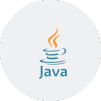

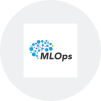

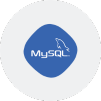



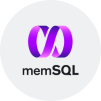

 Join our Live Instructor-Led online classes delivered by industry experts
Join our Live Instructor-Led online classes delivered by industry experts